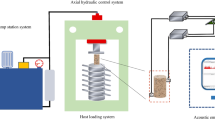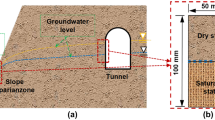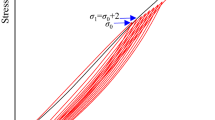Abstract
Water is one of the most significant factors influencing the mechanical properties of rocks. Triaxial unloading acoustic emission (AE) tests were performed to study the unloading mechanical characteristics and damage evolution mechanism of shale with various water contents. The damage evolution characteristics of shale under triaxial unloading conditions were analyzed using AE time series parameters. The results show that when the water saturation coefficient rises, the number of AE rings and the energy value of shale decrease. Based on the results of the AE test, the ratios of the crack initiation stress and damage stress to the peak stress are 0.4 ~ 0.6 and 0.9, respectively. The closure stress, crack initiation stress, damage stress, and other characteristic stresses determined by the stress axial strain method and the AE method all decrease with the increase of the water saturation coefficient, demonstrating that water has a significant impact on the mechanical characteristics of the shale during the unloading damage process. Based on the test results, a statistical damage constitutive model is established, and it uses the AE cumulative ringing count to represent the damage variable. The calculated results of the model are in good agreement with the experimental data, indicating that the established model can more accurately depict the evolution process of shale unloading damage and failure under different water contents. The study's findings can be used as a reference for determining the extent of rock damage caused by water–rock interaction.









Similar content being viewed by others
Data availability
The data used to support this study are available from the corresponding author upon request.
References
Al-Bazali T, Zhang J, Chenevert ME, Sharma MM (2008) Factors controlling the compressive strength and acoustic properties of shales when interacting with water based fluids. Int J Rock Mech Min 45:729–738
Amann F, Button EA, Evans KF, Gischig VS, Blumel M (2011) Experimental study of the brittle behavior of clay shale in rapid unconfined compression. Rock Mech Rock Eng 44(4):415–430
Bai QS, Tu SH, Zhang C, Zhu DF (2016) Discrete element modeling of progressive failure in a wide coal roadway from water-rich roofs. Int J Coal Geol 167:215–229
Brown ET (1981) ISRM suggested methods: rock characterization testing and monitoring. Pergamon Press, Oxford, pp 81–85
Cai M, Kaiser PK, Tasaka Y (2004) Generalized crack initiation and crack damage stress thresholds of brittle rock masses near underground excavations. Int J Rock Mech Min 41:833–847
Cao WG, Zhao MH, Liu CX (2004) Study on the model and its modifying method for rock softening and damage based on Weibull random distribution. Chin J Rock Mech Eng 23(19):3226–3231
Chinese National Standard SL264-2001 (2001) Specifications for rock tests in water conservancy and hydroelectric engineering. The National Ministry of Water Resources of the People’s Republic of China, Beijing
Dehghanpour H, Lan Q, Saeed Y, Fei H, Qi Z (2013) Spontaneous imbibition of brine and oil in gas shales: effect of water adsorption and resulting microfractures. Energ Fuel 27(6):3039–3049
Eberhardt E, Stead D, Stimpson B, Read R (1998) Identifying crack initiation and propagation thresholds in brittle rock. Can Geotech J 35(2):222–233
Hayatdavoudi A (1999) Changing chemophysical properties of formation and drilling fluid enhances penetration rate and bit life. SPE International Symposium on Oilfield Chemistry, OnePetro
Heiple CR, Carpenter SH, Carr MJ (1981) Acoustic emission from dislocation motion in precipitation-strengthened alloys. Metal Sci 15:587–598
Kachanov L (1986) Introduction to continuum damage mechanics. Springer Science & Business Media, Berlin
Kim JS, Lee KS, Cho WJ, Choi HJ, Cho GC (2015) A comparative evaluation of stress-strain and acoustic emission methods for quantitative damage assessments of brittle rock. Rock Mech Rock Eng 48(2):495–508
Kuilaa U, Dewhurstb DN, Raven SAF (2011) Stress anisotropy and velocity anisotropy in low porosity shale. Tectonophysics 503:34–44
Lemaitre J (1985) A continuous damage mechanics model for ductile fracture. J Eng Mater Techno 107:83–89
Li Q, Wang GH, Lu WB, Niu XQ, Chen M, Yan P (2018) Influence of reservoir water levels on the protective performance of concrete gravity dams subjected to underwater explosions. J Struct Eng 144(9):211–225
Li B, Yang FW, Du PZ, Liu ZH (2022) Study on the triaxial unloading creep mechanical properties and creep model of shale in different water content states. B Eng Geol Environ 81(10):1–16
Lin P, Li SC, Xu ZH (2019) Water inflow prediction during heavy rain while tunneling through karst fissured zones. Int J Geomech 19(8):04019093
Liu BX, Huang JL, Wang ZY, Liu L (2009) Study on damage evolution and acoustic emission character of coal-rock under uniaxial compression. Chin J Rock Mech Eng 5:3234–3238
Liu X, Xiong J, Liang L, Luo C, Zhang A (2014) Analysis the wettability of Longmaxi Formation shale in the south region of Sichuan Basin and its influence. Nat Gas Geosci 25(10):1644–1652
Lockner DA (1993) The role of acoustic emission in the study of rock fracture. Int J Rock Mech Min 30(7):883–899
Lyu Q, Ranjith P, Long X, Kang Y, Huang M (2015) A review of shale swelling by water adsorption. J Nat Gas Sci Eng 27:1421–1431
Lyu Q, Long XP, Ranjith PG, Tan JQ, Kang Y (2018) Experimental investigation on the mechanical behaviours of a low-clay shale under water-based fluids. Eng Geol 233:124–138
Mogi K (1971) Fracture flow of rocks under high triaxial compression. J Geophys Res 76:1255–1269
Morsy S, Sheng JJ (2014) Imbibition characteristics of the barnett shale formation. SPE Unconventional Resources Conference. OnePetro
Ohnaka M, Mogi K (1982) Frequency characteristics of acoustic emission in rocks under uniaxial compression and its relation to the fracturing process to failure. J Geophys Res 87:3873–3884
Peng J, Cai M, Rong G, Zhou CB, Zhao XG (2015) Stresses for crack closure and its application to assessing stress-induced microcrack damage. Chin J Rock Mech Eng 34(6):1091–1100
Rybacki E, Reinicke A, Meier T, Makasi M, Dresen G (2015) What controls the mechanical properties of shale rocks? –Part I: strength and Young’s modulus. J Petrol Sci Eng 135:702–722
Song K, Wang FW, Yi QL (2018) Landslide deformation behavior influenced by water level fluctuations of the Three Gorges Reservoir (China). Eng Geol 247:58–68
Tang CA, Chen ZH, Xu XH, Li C (1997) A theoretical model for Kaiser effect in rock. Pure Appl Geophys 150(2):203–215
Tang M, Wu Z, Wang A, Zuo Y, Lou Y, Sun W (2021) Study on the microscopic fracture process and acoustic emission of shale based on digital image, Geofluids, 2021. Article ID 8874918:1–14
Wong R (1998) Swelling softening behaviour of La Biche shale. Can Geotech J 35:206–221
Wong LNY, Varun M, Liu G (2016) Water effects on rock strength and stiffness degradation. Acta Geotech 11:713–737
Wu S, Ge HK, Wang XQ, Meng FB (2017) Shale failure processes and spatial distribution of fractures obtained by AE monitoring. J Nat Gas Sci Eng 41:82–92
Zhu XJ (1996) Characteristics of soft rocks interacting with water. Min Sci Techno 4(3):46–50
Funding
This work is supported by the Major science and technology projects of the Ministry of Water Resources (No. SKR-2022029), Henan Province Key Research and Development and Promotion Special Project (Scientific and Technological Research) (No.222102320441) and the Postdoctoral Research Grant in Henan Province (No. 202103106).
Author information
Authors and Affiliations
Contributions
BL, FY, and HL wrote the main manuscript text. PD and ZL prepared figures and tables. All authors reviewed the manuscript.
Corresponding author
Ethics declarations
Conflict of interest
The authors declare that they have no conflict of interest in this work.
Additional information
Publisher's Note
Springer Nature remains neutral with regard to jurisdictional claims in published maps and institutional affiliations.
Rights and permissions
Springer Nature or its licensor (e.g. a society or other partner) holds exclusive rights to this article under a publishing agreement with the author(s) or other rightsholder(s); author self-archiving of the accepted manuscript version of this article is solely governed by the terms of such publishing agreement and applicable law.
About this article
Cite this article
Li, B., Yang, F., Li, H. et al. Experimental study on triaxial unloading mechanical properties and acoustic emission response of shale with different water contents. Environ Earth Sci 82, 414 (2023). https://doi.org/10.1007/s12665-023-11124-6
Received:
Accepted:
Published:
DOI: https://doi.org/10.1007/s12665-023-11124-6




